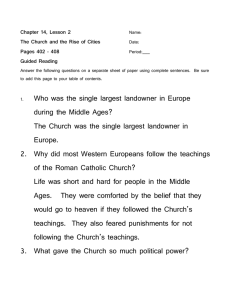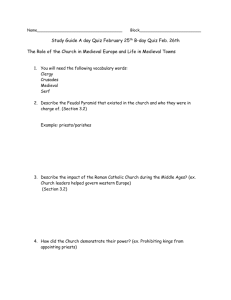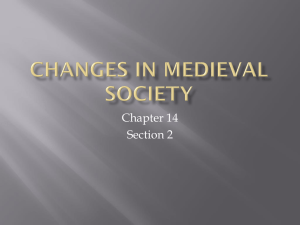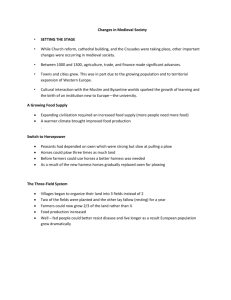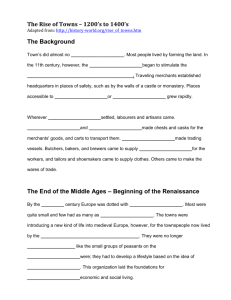2-4 ideas…
advertisement
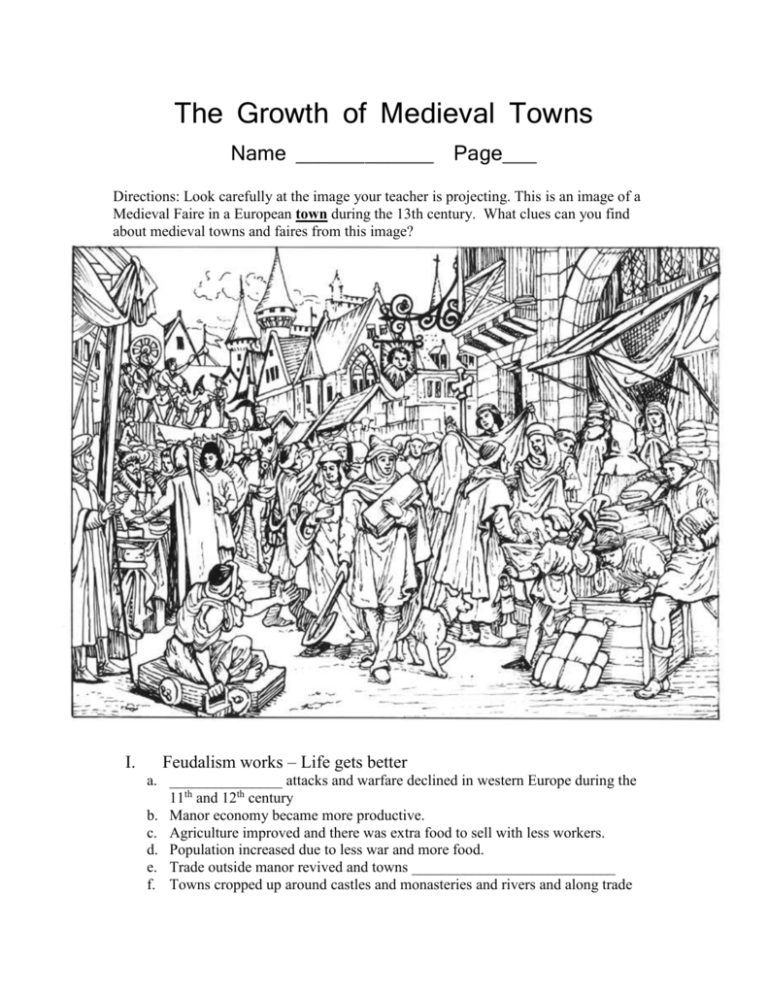
The Growth of Medieval Towns Name ____________ Page___ Directions: Look carefully at the image your teacher is projecting. This is an image of a Medieval Faire in a European town during the 13th century. What clues can you find about medieval towns and faires from this image? I. Feudalism works – Life gets better a. _______________ attacks and warfare declined in western Europe during the 11th and 12th century b. Manor economy became more productive. c. Agriculture improved and there was extra food to sell with less workers. d. Population increased due to less war and more food. e. Trade outside manor revived and towns ___________________________ f. Towns cropped up around castles and monasteries and rivers and along trade routes g. Peasants and nobles became aware of a larger world manor. II. A Medieval Town a. Towns became bustling centers of ___________ and industry. b. Merchants, peasants, serfs and artisans permanently moved near towns. c. Towns were surrounded by ____________ for protection d. Visitors entered through gates in the walls. e. Homes and businesses lined unpaved streets. III. Where were the medieval towns? a. b. c. d. e. Towns located on lands already owned by nobles or the church. Fees paid to lord or church for use of town land. As towns grew, people demanded _________________ and increased rights. Often times, people paid their lord for the charter. But it was worth it. __________________ gave towns control over their own affairs: As a result of the charters, town rulers had say over taxes, property, courts, and serfs were even granted their freedom. f. Population of towns consisted of serf, peasants merchants, artisans IV. Cathedrals a. Most towns were near a large Christian _____________________. b. Cathedrals were built by the masons’ guild. V. Towns purchase charters and become independent a. Town dwellers began to _________________________________ and his demands for taxes as the town became wealthier b. No longer needed the lord’s __________________ – or his interference c. After a town purchased a ________________________, they were free to govern themselves. d. The charter gave people the right to govern themselves, make laws, and raise taxes in their town. e. Free towns were governed often governed by a town council and a mayor. f. Power in Europe began to shift from the lords to ____________________ VI. What is a guild? Why guilds? a. A guild is a group of ________________________________________________________ b. Merchants and artisans given the right to form associations c. Governed prices, wages, standards, disputes and imports/exports d. Only guild members could practice their trade. e. Medieval towns became places where many goods were made VII. Guild Practices a. b. c. d. e. f. g. h. i. Protected ______________________ ‘Just Price’ for goods Set work week, hours, pay Social welfare programs Entertainment and religious feasts Training; apprentice, journeyman and master craftsman. Could take _________________________ to become “master” Guilds prevented competition Passed down through the family Guilds – Apothocary, Bakers, Barbers, Carpenters, Armorers, Blacksmiths, Brewers, Masons, Candlers, Glassmakers, Cobbler, Bookbinders, Hatters, Goldsmith, Embroider, Actors, Minstrels. Relate to History: Which three would you most easily fit into and why? _____________________________________________________________________ VIII. Annual Medieval Trade Fairs a. b. c. d. IX. Large towns became the hosts of huge medieval faires. Faires became a great place to trade goods and ideas. Entertainment was common. Typically, there would be four faires a year in large towns. Faire Days were like large Flea Markets a. b. c. d. Many people from all over the area. Very colorful Jugglers, dancers, clowns, and minstrels provided entertainment Guild members dressed in special costumes and carried banners while parading through the streets e. Guilds put on mystery plays f. Mystery plays gave rise to miracle plays, another type of religious drama g. The church eventually disapproved of both types of plays, but people still enjoyed seeing them acted out in the streets or the public square X. Faires increase the size of towns a. b. c. d. e. f. Trade fairs become elaborate events Mixing place of customs, languages, and goods. Brings people together. Growth in trade, encouraged by the Trade Fairs helped towns grow Merchants moved permanently into the towns Inns were opened for travellers g. Bakers, shoemakers, armorers, blacksmiths, masons, apothecaries, barbers, carpenters and tailors settled in towns to provide needed goods and services h. Rural peasants would come from manors to sell extra produce to townspeople i. Towns specialize; Flanders produces wool, other lace or leather. Towns become interdependent again like during the Roman Empire days. What impact do you think towns have on the feudal and manor system? Why? (2-4 ideas…) ______________________________________________________ ______________________________________________________ XI. Jews in Medieval Towns a. Sizeable Jewish communities in Medieval towns b. Experienced _____________________________ c. Difficult to earn a living due to the hostility of Christians (sometimes backed up by laws) d. Jewish property and belongings were taken at will by their lords e. Were sometimes targets of violence f. One opportunity was to become bankers and moneylenders which was an essential service for the economy g. Jews were looked down upon and abused for practicing this “wicked” trade Take additional notes here: XII. Medieval Entertainment: XIII. Crime and Punishment XIV. Trials Visual Challenge: Go back to the image on the front of this page. Show that you’ve learned about life in medieval town by adding FIVE different annotations to the picture that answer the question: What is life like in a medieval town?


